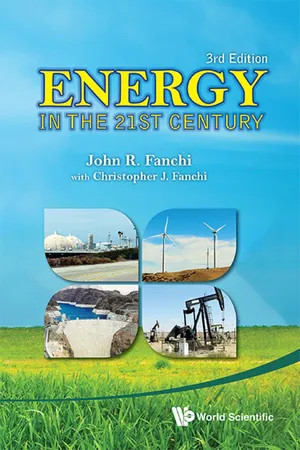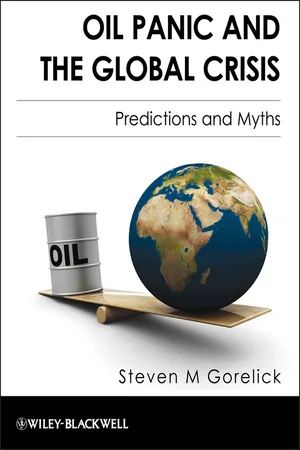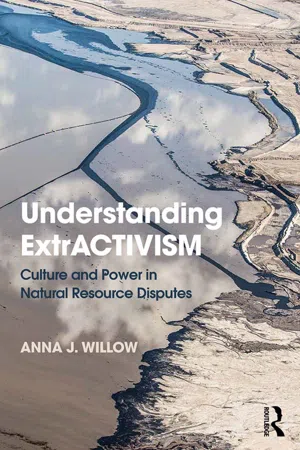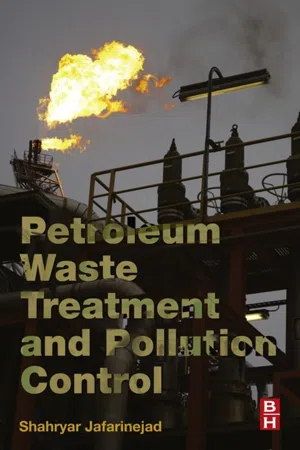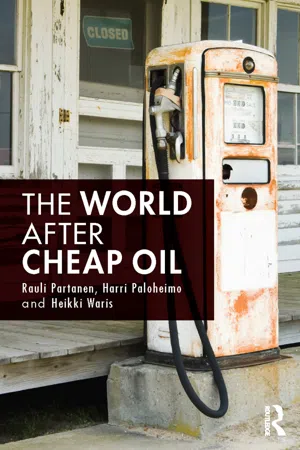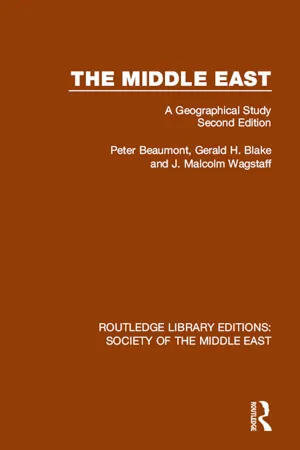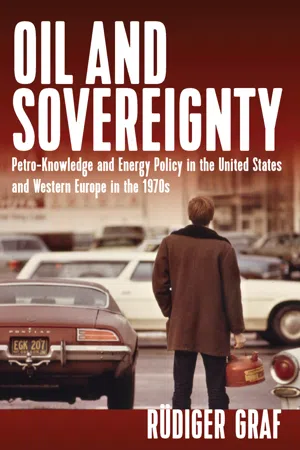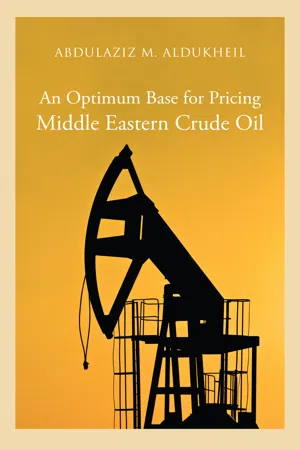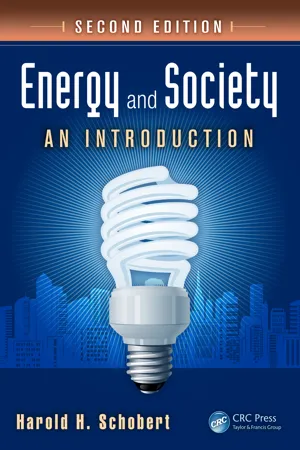Geography
Oil and Petroleum
Oil and petroleum are natural resources formed from the remains of ancient marine organisms. They are crucial to the global economy as they are used as energy sources and in the production of various products. The extraction, refining, and distribution of oil and petroleum have significant environmental, economic, and geopolitical implications.
Written by Perlego with AI-assistance
Related key terms
11 Key excerpts on "Oil and Petroleum"
- eBook - ePub
- John R Fanchi(Author)
- 2013(Publication Date)
- WSPC(Publisher)
The objective of this chapter is to describe how oil and gas resources are formed and distributed throughout the world. We begin by discussing the geologic environment in the next section.Point to Ponder: What is petroleum?The term petroleum is widely used but inconsistently defined. The Society of Petroleum Engineers (SPE) defines petroleum as “naturally occurring liquids and gases which are predominately comprised of hydrocarbon compounds”[SPE Definitions, 2009]. By contrast, the United States Energy Information Administration defines petroleum as “a broadly defined class of liquid hydrocarbon mixtures. Included are crude oil, lease condensate, unfinished oils, refined products obtained from the processing of crude oil, and natural gas plant liquids.”[US EIA Glossary, 2012]. Both SPE and EIA define petroleum as naturally occurring mixtures of hydrocarbon molecules. The SPE defines petroleum in terms of liquids and gases, while EIA defines petroleum in terms of liquids and keeps gas separate. It is important to recognize context to understand the meaning of the term petroleum.3.1 GEOLOGY OF OIL AND GAS RESERVOIRSNaturally occurring hydrocarbon mixtures are usually found in the pore space of sedimentary rocks. The collection of physical and chemical changes that occur during the conversion of sediments to rock is called diagenesis. According to the rock cycle, sedimentary rocks are formed by erosion, transport, deposition, and cementing of igneous rock. Unlike sedimentary rocks, igneous and metamorphic rocks originated under conditions of high pressure and temperature that did not favor the formation or retention of petroleum. Any oil and gas that might have occupied the pores of a metamorphic or igneous rock would ordinarily be cooked away by heat and pressure. Consequently, we focus our attention on sedimentary rock formations as geologic environments for containing oil and gas.3.1.1 Rock Attributes The key attributes used to classify sedimentary rock are mineral composition, grain size, color, and structure. Each of these attributes is considered here. - eBook - ePub
Oil Panic and the Global Crisis
Predictions and Myths
- Steven M. Gorelick(Author)
- 2011(Publication Date)
- Wiley-Blackwell(Publisher)
Despite media images to the contrary, oil is not formed from the decomposed remains of dinosaurs. Over the millions of years, or “geologic time,” that oil was formed and trapped in sediments and rocks, dinosaurs either did not exist or were greatly outnumbered by very small aquatic plants and animals that are collectively termed “plankton.” These mostly microscopic biota account for the greatest volume of organic matter that was available to form petroleum, from which oil is refined. It is estimated that each gallon of gasoline is the ultimate product of 90 metric tons (198,000 pounds) of ancient plant matter, which is 27,000 times the weight of the gasoline. 2 Oil is a small fraction of fossil fuels, which are non-renewable (over the time frame of civilization), natural compounds consisting mainly of hydrogen and carbon (hydrocarbons) formed in the Earth’s crust and including coal, oil, and natural gas. Oil is not the same thing as petroleum. Petroleum includes natural gas as well as crude oil and processed fuel products, whereas oil is the liquid that is refined to yield products such as gasoline, jet and diesel fuel, and lubricants. There are some definitions related to oil availability that are central to the discussion of oil. A resource is “a concentration of naturally occurring solid, liquid, or gaseous material in or on the Earth’s crust in such form and amount that economic extraction of a commodity from the concentration is currently or potentially feasible.” 3 A more specific definition for petroleum resources is, “Concentrations in the earth’s crust of naturally occurring liquid or gaseous hydrocarbons that can conceivably be discovered and recovered.” 4 The oil endowment includes the estimated oil resource plus all of the oil that has been pumped from the ground. A subset of resources is reserves - eBook - ePub
Understanding ExtrACTIVISM
Culture and Power in Natural Resource Disputes
- Anna J. Willow(Author)
- 2018(Publication Date)
- Routledge(Publisher)
Today, over half of producing wells yield both substances. 5 Together providing more than half of the energy consumed worldwide (33 percent is derived from oil and 24 percent from natural gas), petroleum continues coal’s legacy. It allows humans to overcome the limits of annual solar income by granting access to vast amounts of stored fossil energy. 6 Set apart from most prized resources by its non-solid state, petroleum differs from coal in its extraction method (it is usually pumped rather than mined), its portability and versatility, and its marketing as a modern marvel. There are thousands of oil and natural gas extraction zones (fields and plays in industry lingo). Venezuela has the largest proven (meaning commercially recoverable) oil reserves of any single nation. In regional terms, the Middle East is exceptionally rich in oil, with Saudi Arabia, Iran, Iraq, Kuwait, and the United Arab Emirates all among the top ten oil holders. 7 Canada (ranked third in proven reserves), Russia (ranked eighth), Libya (ninth), Nigeria (tenth), and the United States (eleventh) also have large amounts of extractible oil. 8 The list is similar, although not identical, when it comes to natural gas. 9 The specific techniques used to extract oil and gas depend primarily on geological factors, but are also influenced by local regulations, surface topography, and population distribution. BOX 7.1 UNCONVENTIONAL EXTRACTION The term unconventional refers to the use of recent technological innovations to extract oil and natural gas from formerly inaccessible geological formations. For the first century of oil and gas production, extraction entailed drilling a well vertically into the ground and pumping petroleum to the surface. The permeability and porosity of targeted sedimentary rock determined how much of the desired substance appeared (oil and gas flow relatively easily through sandstone, for example, but are more tightly trapped in shale) - eBook - ePub
- Shahryar Jafarinejad(Author)
- 2016(Publication Date)
- Butterworth-Heinemann(Publisher)
1Introduction to the Petroleum Industry
Abstract
Petroleum is vital to many industries and in the manufacture of a wide variety of materials; it accounts for a large percentage of the world's energy consumption, and thus is a critical concern for many nations. This chapter gives a general introduction to the petroleum industry. It begins with the terminology, history, composition, classification, and characterization of petroleum (crude oil and natural gas). This discussion is followed by the world’s distribution of petroleum resources and reserves, the types of oil reserves, the world's largest oil and gas companies by proven reserves, and utilization of petroleum. Finally, the petroleum industry sectors (upstream, midstream, and downstream) are introduced along with exploration, development, and production; hydrocarbon processing (refineries and petrochemical plants); storage, transportation, and distribution; and retail or marketing.Keywords
Crude oil; Exploration; Natural gas; Petroleum industry; Production; Refinery1.1. Petroleum
The word “petroleum” means “rock oil,” and is derived from the Latin words petra (rock) and oleum (oil), which come from the Greek words πέτρα and ἔλαιον, respectively (Hyne, 2001 ; Organization of the Petroleum Exporting Countries (OPEC), 2013 ; Jafarinejad, 2016a ), meaning crude oil and natural gas (Jafarinejad, 2016a ). In the other words, petroleum is a mixture of naturally occurring hydrocarbons that may exist in any state, depending on the conditions of subjected pressure and temperature. Petroleum is produced from reservoirs in either liquid (crude oil) or gaseous form (natural gas), depending on the state of the hydrocarbon mixture. Clearly the word petroleum can cover both naturally occurring unprocessed hydrocarbons and petroleum products that are made up of refined hydrocarbons (Speight, 1999 ; OPEC, 2013 ; Verşan Kök, 2015 ; EIA Energy Kids-Oil (Petroleum), 2011 ; Hyne, 2001 ).1.1.1. History
- eBook - ePub
- Vasily Simanzhenkov, Raphael Idem(Authors)
- 2003(Publication Date)
- CRC Press(Publisher)
Part II REGIONAL PETROLEUM INDUSTRY
OVERVIEWIt would be appropriate to say at this point that this chapter deals more with crude oil economy than with crude oil chemistry. However, the aim of this chapter is to show the importance of crude oil chemistry not only for crude oil chemists, but also for all of mankind. Almost everything around us is derived from crude oil, This includes plastic parts, car fuel, jet fuel, oils, and even asphalt on the road; these are all made from petroleum. It is hard to imagine what modern life would look like without these items, which began their existence from the oil well.Petroleum is responsible not only for making our life more comfortable, but also it has a great influence on international politics. It is well known that crude oil is often called “black gold”. This name emphasizes the importance of petroleum vis-à-vis the world economy.The foregoing discussion explains why this chapter deserves a place in this book. It helps us to understand the importance of crude oil chemistry for the people making decisions about the future of petroleum education, for example. This chapter shows new impressive sides of this branch of study.Passage contains an image
33 Petroleum Producing Countries: OPEC and Non-OPEC
3.1 INTRODUCTION
The many applications of petroleum have been known from ancient times. Initially, primitive ways were employed in petroleum operations. Examples include collecting petroleum from the ground surface and the processing of oil sands. The development of the petroleum industry started when mechanical drilling for oil wells for petroleum production was employed in 1859 in the USA. Practically all petroleum extracted in the world now makes use of mechanical drilling.At the moment, there is a reserve of up to 140,000 million tons of economically exploitable petroleum referred to as proven reserves. About 3,400 million tons of crude oil is processed annually in refineries to high-quality finished products. Petroleum has played a very important role in the economy of many countries. - eBook - ePub
- Rauli Partanen, Harri Paloheimo, Heikki Waris(Authors)
- 2014(Publication Date)
- Routledge(Publisher)
13 Seen from the point of oil, it is no big wonder that their economies are in trouble. Of course part of the decline in oil use is due to gains in efficiency; European cars have ever stricter emissions targets and better fuel economy, and the use of heating oil is dropping in many countries. It would, however, be rather optimistic to assume that the drop in oil use is solely due to more efficient use of oil. The effects of a shattering economy in one country will also be felt in its trade partners, if indirectly.The most important strategic resource
From a geopolitical or an economic view, oil is currently the most important strategic resource on earth. In the Second World War, it was the availability of oil that dictated the strategies and timings of many actions taken – such as the German assault against the Soviet Union or Japan’s attack on Indonesia.14 Later, the price of oil and therefore the income gained from it played a crucial role in the struggle between the communist and capitalist systems in the 1980s. The crash in oil prices then played a major role in the downfall of the Soviet economy, and society along with it. Now the price increase of the same oil is playing its part in helping Russia to flex its geopolitical muscles once more, growing its influence in world politics.Oil deposits are distributed on a geological basis, without regard for national borders or the needs of people. The Near East, for example, is said to hold around 60 percent of proven global crude oil reserves. The largest oilfield in the world, Ghawar, is located in Saudi Arabia. Almost all modern humans need oil, even if it is not present inside their national borders. More than 90 percent of the oil used by humanity has been used after 1960. This is a major reason why oil, and the shared global dependency on oil, has been growing in importance in global geopolitics and, with it, grow the risks.As the thirst for oil in countries such as China continues to grow, the geopolitical situation is likely to get ever tighter. China is currently securing its future oil imports by doing bilateral trade agreements with different producers. Saudi Arabia, for example, has been promised a 49 percent share in new refineries being jointly built in China, effectively securing future supplies of crude oil for the refineries. The leaders of all countries will naturally aim to secure oil for their citizens. As oil production fails to meet demand, this could conceivably lead to tightening international relations and bilateral deals made under the table. Ultimately, the oil will be had by nations and buyers that are most capable, militarily or otherwise, of securing it for themselves. - eBook - ePub
The Middle East
A Geographical Study, Second Edition
- Peter Beaumont, Gerald Blake, J. Malcolm Wagstaff(Authors)
- 2016(Publication Date)
- Routledge(Publisher)
CHAPTER 9 Petroleum 9.1 IntroductionOne of the most spectacular economic achievements of the past 100 years has been the growth and development of the petroleum industry. In 1850 world oil production was virtually non-existent. Then, following discoveries in both the USA and Russia, total output began to rise rapidly after 1860 until by 1890 world production had reached 10 million tonnes per annum (Figure 9.1 ). From this date until the mid-1970s oil production continued to expand with world output doubling approximately every 10 years. 1975 recorded the first fall in oil production in over a century, but this quickly picked up to a new peak of 3225 million tonnes in 1979. Since then a downward trend has been registered.At the beginning of the twentieth century oil and natural gas supplied less than 4 per cent of the total energy requirements of the Western world, while coal accounted for approximately 90 per cent. This picture quickly changed, however, with the share of oil and natural gas in total energy production rising to 12 per cent in 1920, 26 per cent in the mid-1930s, and 36 per cent following the Second World War in 1948. Since this time, the importance of petroleum in the world’s economy continued to grow, so that by 1970 approximately 70 per cent of the total energy requirements of the West were being supplied by oil and natural gas. By 1985 although the relative importance of petroleum was declining, it still accounted for 63 per cent of the primary energy consumption of the OECD countries.1The main users of petroleum and related products are the industrialized nations of Western Europe, North America, Australasia and Japan, which together consumed 56 per cent of the total production in 1985. These same countries, however, produce only 29 per cent of the world’s oil and 50 per cent of the world’s natural gas, and so have to satisfy their demands by imports. As a result a symbiotic relationship has grown up between the major producing and consuming countries. - eBook - ePub
Oil and Sovereignty
Petroknowledge and Energy Policy in the United States and Western Europe during the 1970s
- Rüdiger Graf(Author)
- 2018(Publication Date)
- Berghahn Books(Publisher)
85A few years earlier, the oil industry in the United States had celebrated its centenary, and to mark the occasion in 1959 the Oil and Gas Journal published a special issue that traced the development of the industry, exploration, drilling technology, extraction, transportation and processing. The history of oil, as stated in the introduction, which set the tone for the entire issue, was the ‘greatest romance’ in economic history: ‘It is the story of a discovery which more radically reshaped human affairs and more completely affected human behavior than any other event of the past 100 years. This discovery transformed vision into reality, annihilated distance, and made personal comfort commonplace’.86 This had occurred thanks to the greatest industrial pioneers of American history, who had displayed ingenuity, courage and acumen: ‘Because of them a new empire grew out of swamps and deserts and creek bottoms and wastelands’.87 An advertisement taken out by Sun Oil also asserted that a ‘special breed’ of ‘determined men’ had turned oil into a ‘public servant’, thus improving the quality of life in the United States.88 The Lone Star Steel Company, one of the many steel firms that produced equipment for oil wells, created a new logo featuring the figure of ‘Joe Roughneck’, a robust, helmet-wearing worker with a plaster on his face. For the Lone Star Steel Company, the term ‘roughneck’, a colloquialism applied to men who did hard physical labour in dangerous surroundings, particularly in oil production, captured the habitus of every employee in the oil industry, ‘whether he’s in the field or whether he has come up through the ranks to head of his company’.89 Suppliers in the steel industry strove to outdo one another in describing the toughness and reliability of their products, which were often linked with the characteristics of the workers in the oilfields.90 The entire imagery of the advertisements in the Oil and Gas Journal and Journal of Petroleum Technology , as well as the photographs and illustrations accompanying articles such as ‘It Takes Men to Drill Wells’, underline the archaically manly, tough and rustic habitus cultivated in the oil industry.91 From time to time, this image finds its way into historical narratives of oil, where, for example, Daniel Yergin envisages the heroes and adventurers of the oil economy engaged in a struggle over the ‘prize’ of oil.92 - eBook - ePub
Geopolitics of Energy in Central Asia
India's Position and Policy
- Ramakrushna Pradhan(Author)
- 2020(Publication Date)
- Routledge India(Publisher)
As far as hydropower is concerned, it is quite important from a geopolitical standpoint. But it is strictly confined in a regional context and that too only in some parts of the world like South Asia and Central Asia. Given the changing nature of energy geopolitics, it is often referred to as the New Geopolitics of Energy.Nevertheless, there is a growing debate over the impending exhaustion of oil and other energy sources. It has been reiterated several times by the Peak Oil theory that Russia is producing at its peak and Saudi Arabia has limited additional short-term capacity. Due to commercial disputes, regional instability, civic unrest and political coups in the Persian Gulf, investors are thoroughly worried about their energy security concerns. In this scenario, the issues of energy security are now moving beyond the exclusive concerns of consumers. Producers too require a stable regime with a coherent demand and supply scenario. Although global reserves have been the principal factors in the influencing, if not defining, the energy security debate, it may be recalled that the Club of Rome Thesis cautioned the world community about the limited span of non-renewable sources of energy in its paper “There are Limits to Growth” (Club of Rome, 2011). That is why perhaps the global scramble for oil and energy has taken a fast track route all around geopolitical landscapes abundant in energy resources. It is in this context that the Central Asian geographical landscape has been dealt with specifically in terms of its energy potentials and capacity to meet world energy demand in general, implicating Indian energy security in particular.Geopolitics of oil and gas: strategic resources for power and security
The struggle for the control of energy sources, especially oil and gas, has been central to international politics since the early 20th century. The politics of energy involves stiff competition, dynamic foreign policy formulation and decision making; unprecedented power play and struggle for control, wars, coups and assassinations; fall of governments, economic crises, environmental disasters and corrupt governance as well as sustainable growth, technological innovation and social welfare. This section elaborates by introducing the contemporary politics of energy and attempts to discuss the causes, dynamics and implications of the global quest for energy. It especially focuses on the dynamics of oil politics and offers an introduction to the intricate and often misunderstood world of oil. For that purpose, strategic interests based on access to oil, big oil corporations, international cartels, the economics of the oil market, environmental risks and policies to generate alternative sources of energy are covered at some length. Some of the questions covered in this section are: Why is oil central to international politics? What factors cause wild fluctuations in oil prices? How viable are alternative energy sources? Does greater energy consumption inevitably lead to irreversible environmental costs? What are the prospects for energy scarcity? - Abdulaziz M. Aldukheil(Author)
- 2020(Publication Date)
- Saqi Books(Publisher)
In this chapter, I will describe the different efforts aimed at developing the theory of petroleum production. The chapter is divided into three main sections. The first part deals with the physical and technical characteristics of petroleum production. The second will be concerned with the cost of production, its nature, and classifications. The third part will present a theory of petroleum production. Cost has to be measured so that it can be compared with price in analysing industry behaviour. The measurement of cost is the subject of the first section in the third part. The second section will deal with the adjustment mechanism of supply and prices in its short and long-run perspectives.Physical Characteristics of Petroleum ProductionIt is essential for the full appreciation of the economics of petroleum that we understand its physical characteristics. The combination of these characteristics makes the optimal use of petroleum resources a special one. The following description of these physical phenomena is intended only to introduce the pertinent terminology and thus is limited to the bare essentials.The Nature of PetroleumPetroleum is a generic term denoting all natural hydrocarbons except those in the coal family.4 The physical properties of a given mixture in a petroleum reservoir vary with temperature and pressure, but, as delivered to the surface, any mixture is classified as crude oil, natural gas, or a combination of the two, namely natural gas-liquid.The exact origin of petroleum is unknown but, according to the most widely accepted hypothesis, petroleum is formed from the remains of plants and animals buried beneath the sedimentary deposits of ancient seas and decomposed by pressure, temperature, and bacterial action.5- eBook - ePub
Energy and Society
An Introduction, Second Edition
- Harold H. Schobert(Author)
- 2014(Publication Date)
- CRC Press(Publisher)
Pipelines. I.B. Taurus: London, U.K., 2008. A very interesting discussion of how international oil pipelines help to shape political realities. The focus is mainly on central Asia, the Middle East, Europe, Russia, and China.- Klare, M. Rising Powers, Shrinking Planet. Henry Holt and Company: New York, 2008. A book discussing the geopolitics of energy, including oil. Russia, which “lost” the Cold War, is once again becoming nationalistic and arrogant. China and the United States are likely to compete all the more for available energy supplies. Klare argues on behalf of international collaboration as the best way forward.
- Kunstler, J.H. The Long Emergency. Atlantic Monthly Press: New York, 2005. A dismal view of the future, in which two catastrophes converge: global warming and oil depletion. In Kunstler’s view, there is no way that various alternative forms of energy will allow society to rely on energy at the scale we do now.
- McPhee, J. Annals of the Former World. Farrar, Straus and Giroux: New York, 1998. The best book on geology ever written for the nonscientist or nonspecialist reader. Much information on oil geology, including resource issues. Highly recommended.
- Phillips, K. American Theocracy. Viking: New York, 2006. The first three chapters discuss the role of oil in world affairs, and the impacts of America’s dependence on oil, particularly imported oil.
- Simmons, M. Twilight in the Desert. Wiley: Hoboken, NJ, 2005. Based on a careful analysis of numerous papers published in the professional literature of petroleum engineering, Simmons argues that Saudi Arabia is already “overproducing” oil and can no longer be depended upon to ramp up production to stabilize world markets.
- Sperling, D.; Gordon, D. Two Billion Cars. Oxford University Press: New York, 2009. This book discusses, among other topics, possible improvements in energy efficiency in cars, along with the need for transportation planning.
- Tertzakian, P. A Thousand Barrels a Second
Index pages curate the most relevant extracts from our library of academic textbooks. They’ve been created using an in-house natural language model (NLM), each adding context and meaning to key research topics.
